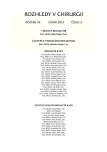Bilateral perinatal torsion of spermatic cord – a case report and literature review
Authors:
M. Drlík; R. Kočvara
Authors‘ workplace:
Urologická klinika 1. LF UK a Všeobecné fakultní nemocnice Praha
přednosta: Prof. MUDr. T. Hanuš, DrSc.
Published in:
Rozhl. Chir., 2013, roč. 92, č. 2, s. 98-101.
Category:
Case Reports
Overview
Introduction:
Perinatal spermatic cord torsion represents a less common manifestation of spermatic cord torsion. In newborns, normal fixation between testicular coverings and tunica dartos is not yet well established, and abnormal testicular mobility results in extravaginal type of torsion. Salvage rate of testes after detorsion is low. Management of perinatal torsion still remains a controversial issue. Some authors refuse scrotal exploration as useless, their opponents recommend emergent bilateral surgical exploration for the protection of the healthy gonad.
Case study:
Authors report a case of a newborn who underwent scrotal exploration for clinical signs of the right-side perinatal torsion. The right completely necrotic testicle was removed. It was decided to fix the contralateral testis to prevent torsion. However, the exploration of the left testicle revealed ischemic damage corresponding to the asynchronous perinatal torsion after its spontaneous detorsion. The testicle was left (preserved) in scrotum and fixed. The follow-up then confirmed the loss of functional testicular tissue. This is the first case of bilateral perinatal torsion described in the Czech and Slovak literature.
Conclusions:
Perinatal spermatic cord torsion may result in a severe complication – bilateral testicular atrophy due to asynchronous torsion of the contralateral testicle. The authors demonstrate that in newborns physical examination and ultrasonography may be not sensitive enough for the assessment of the testis condition. In the light of the case study and literature reviewed they strongly recommend early bilateral scrotal exploration with preventive testes fixation to protect the healthy gonad.
Key words:
spermatic cord torsion – extravaginal torsion – newborn – perinatal torsion – acute scrotum
Sources
1. Tailor MR. A case of testicle strangulated at birth; castration; recovery. Brit Med J 1897;1 : 458.
2. Frederick PL, Dushku N, Eraklis AJ. Simultaneous bilateral torsion of the testes in the newborn. J Ped 1967;71 : 249.
3. Stefan H, Plachý V, Blechová D. Torze varlete u pěti novorozenců. Čs Pediatr 1966;2 : 116–120.
4. Burge DM. Neonatal testicular torsion and infarction: aetiology and management. Br J Urol 1987; 59(1):70–73.
5. Snyder HM, Diamond DA. In utero/neonatal torsion: observation versus prompt exploration. J Urol 2010;183(5):1675–1677.
6. Djahangirian O, Ouimet A, Saint-Vil D. Timing and surgical management of neonatal testicular torsions. J Pediatr Surg 2010;45(5):1012–1015.
7. Roth CC, Mingin GC, Ortenberg J. Salvage of bilateral asynchronous perinatal testicular torsion. J Urol 2011;185(6 Suppl): 2464–2468.
8. Turner TT, Brown KJ. Spermatic cord torsion: loss of spermatogenesis despite of return blood flow. J Androl 1995;16 : 12.
9. John CM, Kooner G, Mathew DE, et al. Neonatal testicular torsion – a lost cause? Acta Paediatr 2008; 97(4):502–504.
10. Das S, Singer A. Controversies of perinatal torsion of the spermatic cord: a review, survey and recommendations. J Urol 1990;143(2):231–233.
11. Drlík M, Kočvara R. Torsion of spermatic cord in children: A review. J Pediatr Urol 2012;2: v tisku.
12. Driver CP, Losty PD. Neonatal torion. Br J Urol 1998;82 : 855.
13. Baglaj M, Carachi R. Neonatal bilateral testicular torsion: a plea for emergency exploration. J Urol 2007;177(6):2296–2299.
14. Brandt MT, Sheldon CA, Wacksman J, et al. Prenatal testicular torsion: principles of management. J Urol 1992;147 : 670–672.
15. LaQuaglia MP, Bauer SB, Eraklis A, et al. Bilateral neonatal torsion. J Urol 1987;138 : 1051.
16. Hayn MH, Herz DB, Bellinger MF, et al. Intermittent torsion of the spermatic cord portends an increased risk of acute testicular infarction. J Urol 2008;180 : 1729–1732.
17. Barth RA, Shortliffe LD. Normal pediatric testis: comparison of power Doppler and color Doppler US in the detection of blood flow. Radiology 1997;204(2):389–393.
18. Chmelnik M, Schenk JP, Hinz U, et al. Testicular torsion: sonomorphological appearance as a predictor for testicular viability and outcome in neonates and children.Pediatr Surg Int 2010;26(3):281–286.
19. Nataraja RM, Mahomed AA. Systematic review for paediatric metachronous contralateral inguinal hernia: a decreasing concern. Pediatr, Surg Int 2011; 5 : 21.
20. Fuhrer S, May M, Koch A, et al. Intrauterine torsion of a testicular teratoma: a case report. A S J Perinatol 2005;25(3):220–222.
21. Levy DA, Kay R, Elder JS. Neonatal testis tumors: a review of the Prepubertal Testis Tumor Registry J Urol 1994;(151),3 : 715–717.
Labels
Surgery Orthopaedics Trauma surgeryArticle was published in
Perspectives in Surgery

2013 Issue 2
Most read in this issue
- Pancreatic fistula – definition, risk factors and treatment options
- Bilateral perinatal torsion of spermatic cord – a case report and literature review
- Laparoscopic repair of incisional hernias – our first experience
- Chest wall haemorrhage as a complication of anticoagulation treatment – a case study
